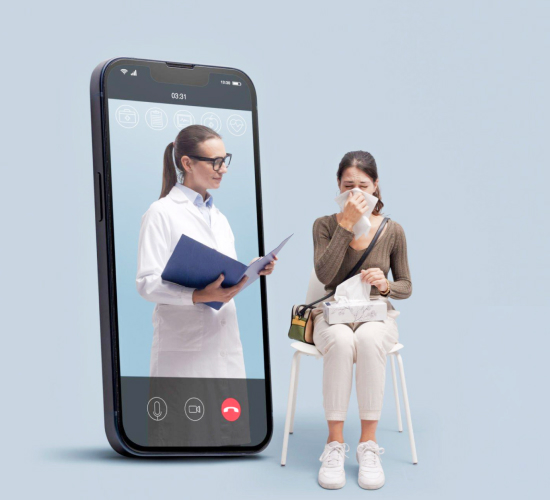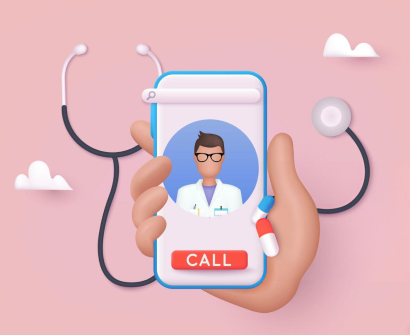

The world has gone remote, and so has medical care. Gone are the days when you had to wait for hours at a doctor’s clinic only to meet the doctor for a few minutes. Today, everything is available online so that you can get the best of medical care sitting in the comfort of your home.
Although telemedicine is becoming increasingly common future, not many of us may have a clear understanding of it. That’s exactly what we will do today. Read on to get a complete understanding of this pathbreaking service that can make your life so much easier.
Let’s start from the very basics and understand telemedicine’s meaning.
A general term, telemedicine refers to different ways in which you and your doctor can use technology to communicate without meeting in person. It enables a person to seek a doctor’s advice on non-emergency situations that do not require a compulsory in-office visit.
Various modes of communication can be used for telemedicine such as phone calls and video chats to interact with your healthcare provider live or emails or other secure systems to send and receive messages. Following up on your treatment is possible through telemedicine. It also enables your doctor to monitor your condition without having to meet you in person. A proper telemedicine platform allows you to check your vital signs and send them to your doctor.
Telemedicine is also known as telehealth, digital medicine, m health (m for ‘mobile’) or e-health. Telemedicine can be used for:

What can you do through telehealth? Here are some of the types of care that you can obtain:
There are many benefits of telemedicine such as:
Telehealth enables people to have access to world-class medical care from the convenience and privacy of their own homes and reduces the need to travel to the doctor’s clinic. This is especially helpful when the patient is not fully mobile or is feeling too weak to travel. If you are working full time or have children to take care of, telemedicine can remove the need to take off from work or arrange child care. It also helps you to avoid waiting at the doctor’s clinic and schedule consultations based on your busy schedule.
Telemedicine provides equal access to healthcare for all. No matter where you are located, telemedicine can help you consult the doctor of your choice. For example, someone located in a village in Kedah can consult a doctor in Kuala Lumpur, without having to travel to the city.
In many cases, telemedicine is a more cost-effective option than physical visits as you save the cost of travelling to your doctor’s location. This is especially applicable if you are located in an area far away from your doctor’s clinic.
Sometimes, your family members may not be able to travel to the doctor’s clinic with you for an appointment. Telemedicine allows them to join if they like. They can ask questions, which in turn can help all family members to be better informed about your condition and what kind of care you need.
Through telehealth consultations, you reduce the risk of contracting someone else’s infection while waiting at the doctor’s clinic. This helps you to stay safe from viral infections such as cough and flu.
To understand more about the benefits of telemedicine, we recommend you also read our article on the Benefits of Telehealth Consultation.
Unfortunately, not yet. While telemedicine can be helpful in many ways, it still cannot replace all kinds of doctor visits.
For long-term care, such as if you have diabetes and hypertension, you can use telemedicine to keep your doctor updated about your condition. However, for urgent care, you will need to go to the doctor’s office. For example, if you have a common cold and fever, you can use telemedicine, however, if you have sinus pain, your doctor would like to meet you in person to check you and figure out what’s causing it.
For things that your doctor needs to see you in person, such as a backache, or a twisted ankle, a visit to the clinic cannot be avoided.
Of course, telemedicine cannot be used for seeking any emergency medical help.
Yes, we know, that when it comes to anything online, your primary worry is privacy. And justly so, considering the rise of phishing and scams around the world.
Well, this is where the importance of using a good telemedicine app comes into play. A secure telehealth app or portal uses proper kinds of encryption to enable one to stay safe.
From the consultation side, telemedicine follows the same rules about protecting your privacy as an in-person appointment. From your side, we suggest being in a room away from outsiders or your car. If you are attending the telemedicine consultation appointment from a public place such as a park, ensure no one’s around you, when you chat with your doctor. If you cannot find a private spot, it is suggested to reschedule the appointment.
Here are some additional tips for your safety online:
Now that you know about telehealth benefits, let’s see how it works. Well, you can access telemedicine in different ways, the two most common ones being:

These are specialised secured apps which enlist various kinds of medical services such as general physicians, specialised doctors, dieticians, psychiatrists, mental health counsellors and more. Different apps provide different kinds of services. Most of them allow you to schedule appointments with your choice of doctor. Many platforms integrate calling or video calling facilities so that you can attend the appointment from the app itself. Some platforms enable you to get emails from your doctor, set up follow-up appointments as well as ask for prescription refills.
You can also share your lab results with your doctor to help them monitor your condition. Since these platforms are solely dedicated to telemedicine, they offer enhanced security, so that you don’t need to worry about your privacy.

Some doctors also offer direct consultation with them through phone calls or video conferencing, without going through a third-party app. These appointments work similarly to how physical appointments work.
However, such appointments are done through a third-party video conferencing app or over a regular phone call, so privacy can be an issue.
Like all technologies, telemedicine is not free of drawbacks. However, the good news, there are ways to overcome these drawbacks too. Let’s take a look at a few of these drawbacks and how you can avoid letting it hamper your consultation with your doctor.
Let us now talk about how you can choose a telehealth provider. We recommend you consider several factors before making the final choice. Here are some of the things that you should look at:
One of the primary things to consider is how simple is the telemedicine software. The app should not be challenging to use for you. You should be comfortable with the interface.
The best telemedicine platform is not only simple to use, but combines all the services that you may need. Ensure that the app you choose allows you to interact with your doctor in various ways such as phone calls, video calls, chat, email, etc. You should be able to send messages to your doctor so that they can respond when they are free.
Another important thing to check is how easy it is to schedule appointments. Does it allow flexibility in dates? Can you schedule an appointment in a few clicks? It is also crucial to check that the app sends reminders about appointments and follow-ups. This will take the burden of remembering your appointment schedule off you and make life easier for you.
There are many things you can do to ensure that your telemedicine appointment is a successful one. Remember, you only have a few minutes with your doctor, you don’t want to spend the time fixing a technical glitch or forgetting certain important things that you should have asked.
Here are a few tips to have a successful telemedicine appointment:

TrueCare2U is a leading telemedicine provider in Malaysia, offering a host of services to cater to your every kind of need. Premium medical officers, specialist doctors, psychologists and dieticians are enrolled on this telemedicine Malaysia platform. You also get a range of options for your consultations such as phone calls, chat and video calls.
Not only telemedicine, TrueCare2U is a complete health solution offering various kinds of facilities. You can book home visits to avail different kinds of services to help you recover from surgery, physiotherapy, breastfeeding care and more. You can also book nursing services through the app.
Download the app today and get access to a host of medical services sitting at home.
Telemedicine encompasses various methods for you and your doctor to communicate through technology without an in-person meeting. It allows individuals to consult a doctor for non-emergency situations that don’t require an office visit.
Telemedicine facilitates video or phone appointments between patients and their healthcare providers. It enhances both health and convenience.
Telemedicine mainly centres on delivering medical care remotely, whereas digital health highlights patient involvement in their own care. This can involve tools such as patient portals, which enable patients to access their health information, monitor their progress, and communicate with their healthcare team.
Sources:
Spread the love, follow us on our social media channels